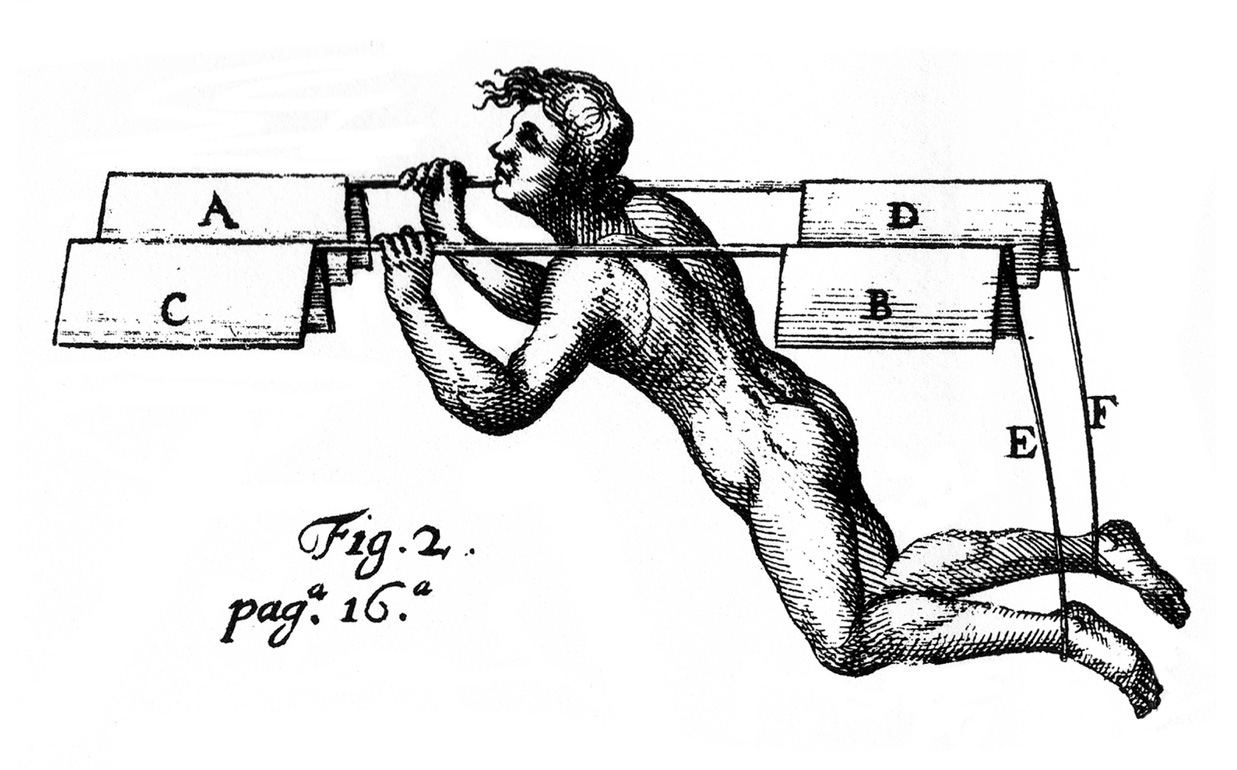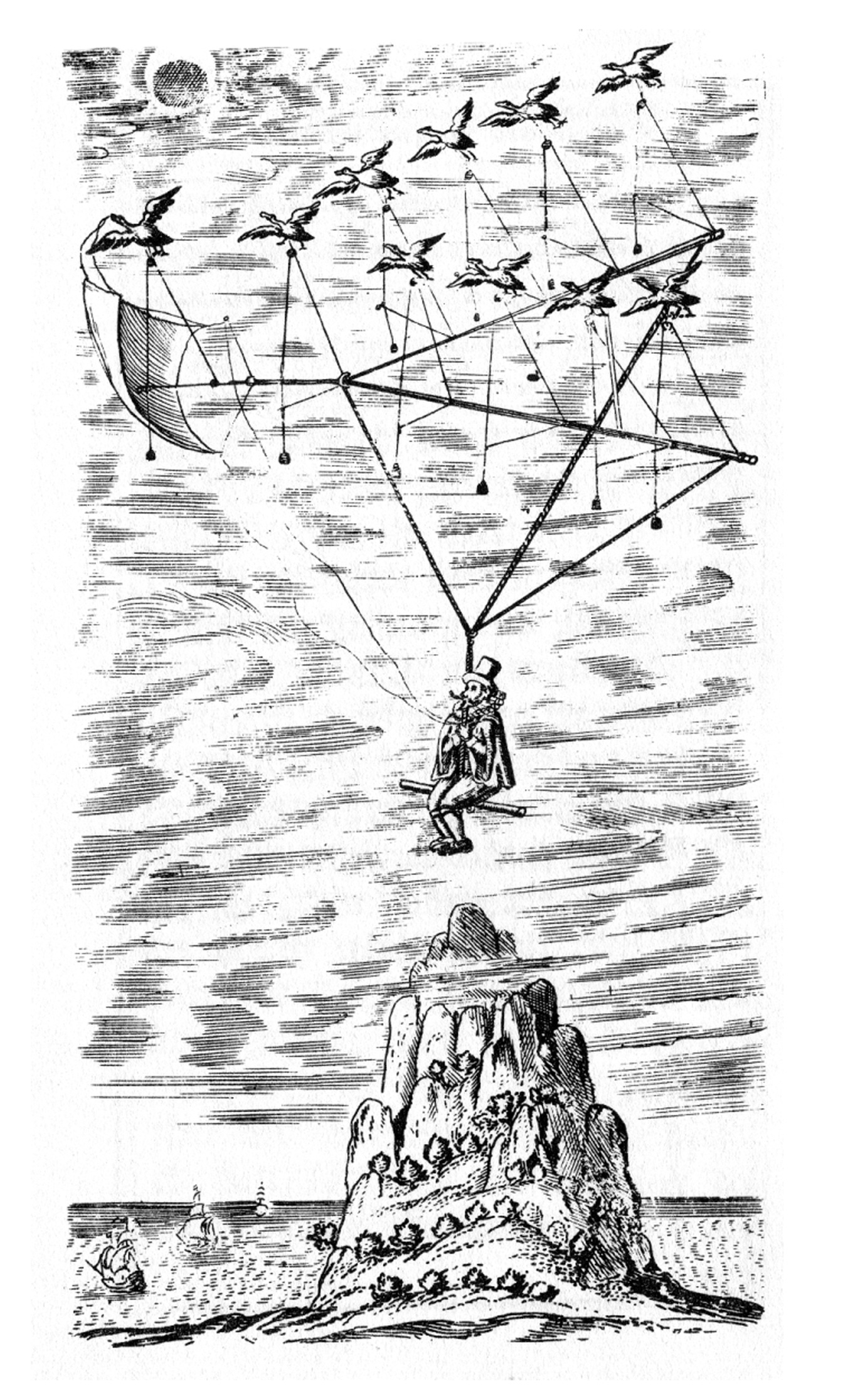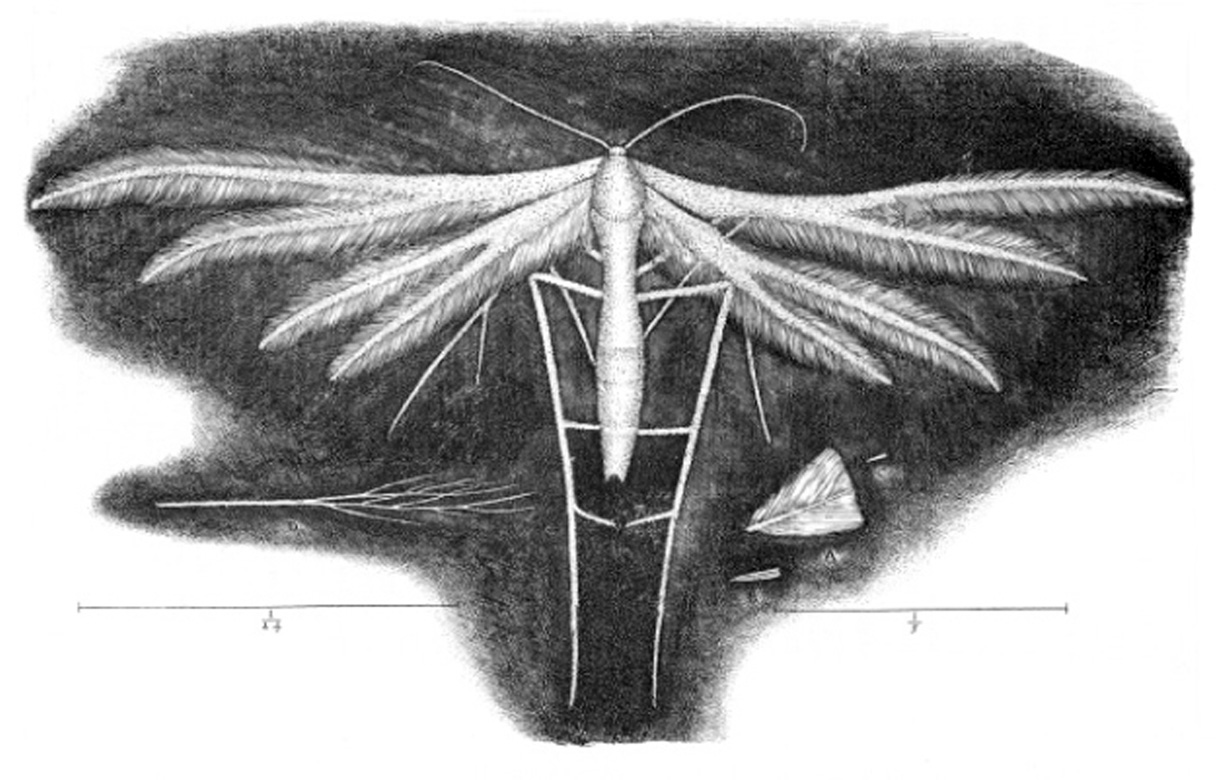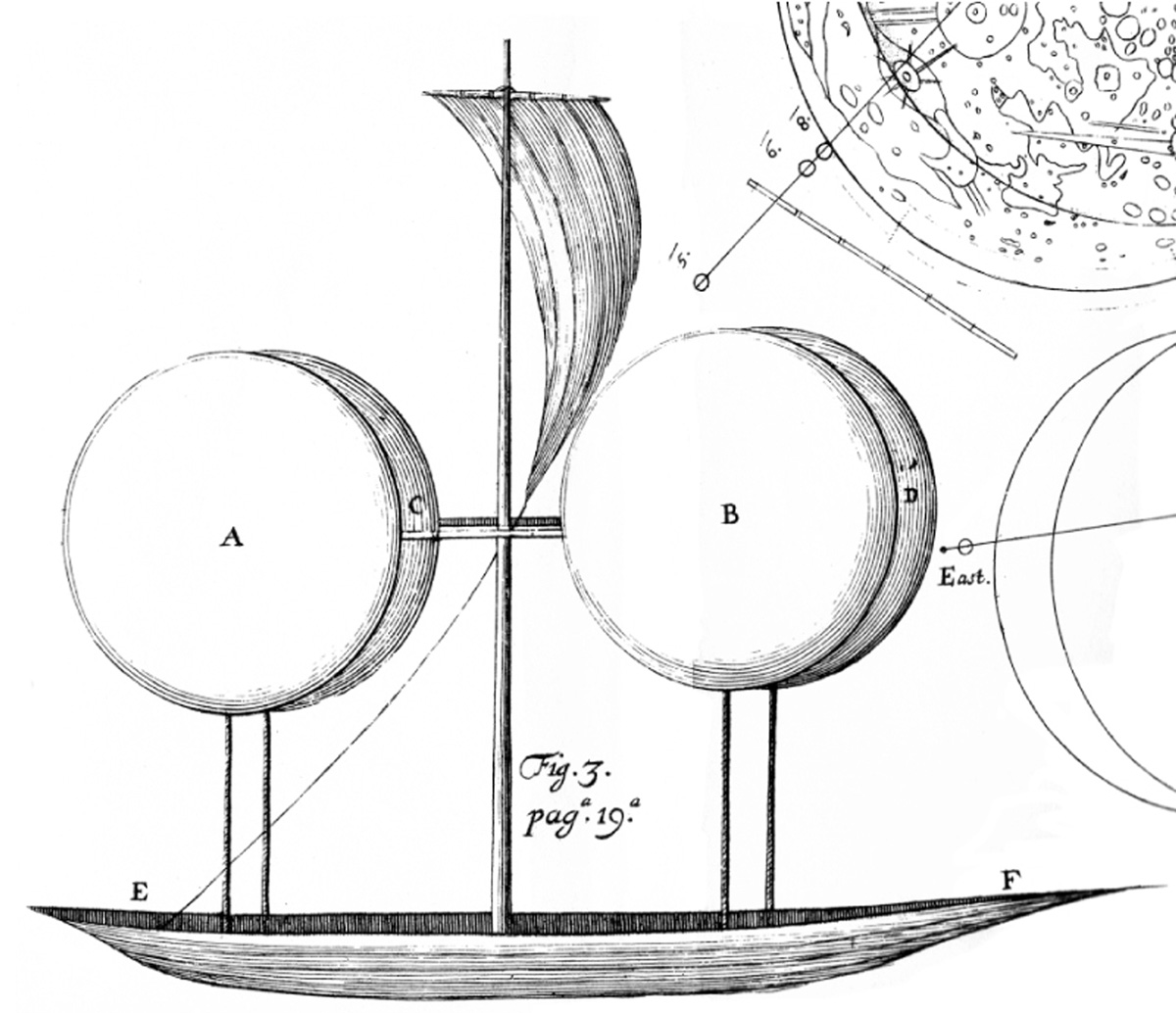Ready for Takeoff
Robert Hooke’s flying experiments
Viktoria Tkaczyk
On 8 October 1674, Robert Hooke made the following note in his diary: “At Councell at Arundell told Sir Robert Southwell that I could fly, [but] not how.”[1] Let us imagine this scene: Hooke, the curator for scientific experiments at the Royal Society in London, just happens to run into his colleague, Southwell. Almost off the cuff, he mentions that he has finally found the key to the puzzle of how a human being can fly. But he does not give away the sensational discovery.
One reason for this may be the fact that the art of flying was still one of the greatest scientific taboos during Hooke’s time. It lay in a realm of secrecy, beyond the boundaries of permitted knowledge. The curiositas that attempted to transgress this boundary was represented by a failed pilot of antiquity: Icarus warned the viewer that high flights would bring calamity, both in a technical and a metaphorical sense. Airspace was sacred space—the gods alone were allowed to soar, weightlessly and mysteriously, through the heavenly regions. Only gradually did flying, through the process of secularization, become what we today conceive it to be: a technically feasible activity that is subject to the laws of aerodynamics.
In the seventeenth century, however, the idea of a flying machine was met with suspicion. René Descartes, for instance, remarked in 1640 that “one could very probably construct a machine that holds itself in the air like a bird, if only in a metaphysical sense, for birds themselves are, at least in my opinion, such machines; but not in a physical and a moral sense, for that would require such delicate and at the same time strong feathers as could not be produced by human hands.”[2] Descartes’s concept of the machine served as a metaphorical vehicle to understand the perfection of birds as natural beings. Made by the best of all craftsmen, God, they definitely had to be inimitable. Gottfried Wilhelm Leibniz, however, was far more trusting of the inventive spirit of his era. He repeatedly studied the plan of the Italian Jesuit Francesco Lana di Terzi for the building of an airship. According to Lana, a brass sphere could rise from the ground by means of the airless space inside it.[3] Leibniz considered the idea to be possible, although he did not believe in the existence of a vacuum and instead suggested the possibility of a filling substance that was lighter than air. Nonetheless, in a manner similar to Lana, who did not dare to construct his own invention for fear of divine wrath, Leibniz also admitted: “If human beings could also elevate themselves into space, … their wickedness could no longer be held in check.”[4] Out of such scruples speaks not the metaphysical argument against flying machines Descartes had proposed, but fear: not the fear of flying demons and witches encouraged by the medieval Inquisition, but rather a new fear of air wars and boundless terror.
For Hooke’s part, he too engaged with the idea of an airship. However, his comments on Lana’s and Leibniz’s panicked words are merely laconic: “A man that hears all these things, and should believe the terrible and mischievous consequences, would possibly be of the Authors mind, …. But hold a little,” he interjected, and proceeded to challenge the idea that there could be “any great harm of this Invention to the Civil and Peaceful Government of the World.”[5] And unlike his Continental colleagues, Hooke was not satisfied with mere thought experiments and fictitious scenarios. As an adherent of experimental philosophy, which favored practical experiments over intellectual exercises, Hooke believed the occult mysteries of nature to be beyond the reach of the “naked eye and [the] unmachined hand.”[6] Instead, one needed actual machines in order to imitate the inexplicable processes of opaque nature in experimental fashion.

And yet, coming at the cusp of scientific modernity, the inadequacy of the technological means available to Hooke meant that his pursuit of the mystery of flight had to be routed through a diverse array of strategies: by constructing actual technical models, which he claimed to have designed even as a student at Oxford; through graphic representations, and acoustic and other experiments; and, importantly, also through elaborate rhetorical gestures that he performed in his oral and written presentations. If this variegated approach was insufficient to resolve the problem of how man might fly, its very inadequacy ironically established a mode of inquiry that developed a life of its own and led to more and more discoveries. Hooke liberated the question of flying from the realm of taboo—at the mythical margin of the world—without ever being able to answer it. However, it was precisely this paradoxical state of affairs that enabled him to investigate the notion of flight and thereby make it nearly thinkable and utterable. For Hooke, flying provided both an object of study and a method of inquiry. Always on the verge of grasping the key to one of the greatest secrets of nature, this transgressive scholar moved in a “transit space” between irreconcilable systems of knowledge. From this position, he created a fundamental disorder in the affairs of natural philosophy.
Even before he undertook physical and anatomical investigations, Hooke’s experiments proceeded according to the principle of trial-and-error, which imbued them with the character of spectacles. He exploited the theatrical quality of an as yet inaccessible knowledge, even when he had to pay for it with a crash landing. Possibly, he was inspired by the “public shews” that also fascinated his teacher, Wilkins. Later, in London, Hooke’s desire to experiment may have been ignited anew by the mechanical spectacles of the English Restoration theater. On 10 December 1673, he made note of a visit to Dorset Garden, where he had seen Elkanah Settle’s tragedy The Empress of Morocco.[8] The production went down in history as a result of its sensational staging, which was said to have employed “machines with witches flying over the Stage and Hecate descending in a basket.”[9]
At times, Hooke’s public demonstrations were perhaps more speculative than spectacular. In the Royal Society protocol of 27 November 1673, it is noted that “Mr. Hooke shew’d an attempt of his, of making a vessel so thin, that when evacuated of the air contained in it, it might swim in the air.”[10] He spoke even more intensively with his colleagues about the topic of flight. Around 7 November 1673, he noted: “To Spanish coffee house with Lingar and Blackburne. Discoursed diverse ways of flying by powder & c.”[11] Of course, the fact that Hooke brought up the topic of flying at every possible opportunity does not mean that his inventions worked. His garrulousness rather became an experiment in itself—a conversational experiment. Word by word, he lured his audience of scientists ever closer to the taboo zone of inquiry. In this performative way, a phenomenon that had hitherto for the most part been hidden in a myth-shrouded silence now moved into the center of attention.

If Hooke’s work owes much to the spirit of Francis Bacon’s then only recently explicated notion of experimental philosophy, it is also indebted to that philosopher’s utopian leanings. In Bacon’s fictional society of Nova Atlantis, for example, a scholar reports, “We have also engine-houses, where are prepared engines and instruments for all sorts of motions; we imitate also flights of birds; we have some degrees of flying in the air.”[13] In addition to Bacon’s work, scientific utopias of flight were also described by Johannes Kepler in Somnium (1622) and in a satirical mode by Cyrano de Bergerac in Histoire comique contenant les estats et empires de la lune (1657). Hooke’s studies were strongly influenced by these fictions. He also made direct references to The Discovery of a World in the Moone (1638) by his professor, Wilkins, who for his part appraised the subject of flying far more positively than Leibniz did later. “I doubt not,” wrote Wilkins, “that it is possible for a man to fly himself … there is not any imaginable invention that could prove of greater benefit to the world, or glory to the author; and therefore it may justly deserve their inquiry, who have both leisure and means for such experiments.”[14] Hooke, ambitious pupil that he was, took the necessary means and time for these experiments. He made a plea to preserve the records of all flight attempts that had hitherto been undertaken by artisans and scientists. To this end, he translated both the aforementioned treatise of Francesco Lana and an account of the attempted flight of the French locksmith Besnier in 1678 that had caused an uproar throughout Europe. In his foreword to the Lana translation, Hooke placed the myth of Icarus in a different light. “The Story of Daedalus and Icarus might have its ground from the attempts of some persons about this matter, though Poetick relations have made them Romantick.”[15] The characters from antique mythology were thus not arrogant heroes, but rather daring craftsmen, whom Hooke elevated to the status of forerunners of experimental philosophy.
Hooke consistently attempted to reformulate and revaluate historical sources on flight. His diaries are characterized by a constant rewriting of the idea of conquering the air. In the years 1673 to 1674, he was still writing elliptically of “ways of flying by powder & c.” and an “experiment … by which flying is easy and carrying any weight.” Between 1675 and 1679, however, he used more precise and mechanical terminology such as “flying chariot,” “flying engine,” “flying pump” and “flying module.”[17] In his 1679 commentary on Besnier’s and Lana’s plans for flying machines, he spoke of a “machine”[18] and a “flying ship.”[19] This constant substitution and shifting of concepts is a typical feature of early modern mechanical treatises. In this way, they contributed more than the inventions themselves to the development of a new mechanical discourse. Through the constant redefinition of the concept of flight, Hooke made accessible an object of research that was in fact still indescribable.

Besides this terminological approach to flying machines, Hooke embedded the topic of flight in different contexts of his writings in what one might almost call a strategic rhetoric. In his major work, Micrographia, he only disclosed fragments of his knowledge. “The way of flying in the Air seems principally unpracticable, by reason of the want of strength in humane muscles; if therefore that could be supplied, it were, I think, easier to make twenty contrivances to perform the office of Wings: What Attempts also I have made for the supplying that Defect, and my successes therein, which I think, are wholly new, and not inconsiderable, I shall in another place relate.”[20] This other place cannot, however, be located in Hooke’s writings. One constantly finds only blurred traces of allegedly performed experiments. If flight had hitherto been considered to be an unfathomable sacred mystery, his references, postponements, and omissions allowed this mystery to be circumscribed and, little by little, reinscribed as a mystery of scientific inquiry. Thus, flying was no longer a sign of divine mobility and not yet a legitimate object of inquiry. It remained in that transitional space of knowledge, here understood as the interior passageways of language. Hooke’s writings are dances that evade the promise of their words with graceful turns. Writing becomes a space of experimentation. Through the reader, Hooke acquires what Steven Shapin has called “virtual witnesses”: witnesses of experiments that probably either never took place at all or were only carried out on paper.[21]
These provocative hypotheses—“twenty contrivances to perform the office of Wings!”—may have both astonished contemporary readers and at the same time awakened their curiosity. In the sixteenth century, wonder was still located in the realm of miraculous apparitions and the art of automata; the desire for knowledge, on the other hand, found its place in the sciences. Hooke united these two cognitive passions and in this way created a structure of inquiry that became typical for the late seventeenth century. However, as Lorraine Daston suggests, this structure only became possible through the breakdown of scientific categories.[22] Hooke broke with the category of the divine mysterium of flight and created newly technologized and ultimately humanistic modes of understanding nature’s secrets. His curiosity transformed the perceiving gaze into a critically evaluating one. Admiration gave way to observation. And only in the eyes of the scientific observer did the miracle of flight appear as an object of inquiry.

Historians of science have sometimes glossed over the experimental philosopher’s passion for research with the assertion that “Hooke’s means of flying were always, as far as we can tell, dependent on his technological wizardry, his mastery of mechanics.”[24] One could, however, also make the opposite argument: that the question of flight developed a life and a dynamic of its own in his research and led him on completely different tracks. One year after the publication of Micrographia, for example, Hooke apparently came one step closer to the mystery of flight. Samuel Pepys describes a conversation with Hooke, in August of 1666, “about the nature of sounds, and he did make me understand the nature of music sounds made by strings, mighty prettily; and told me that having come to a certain number of vibrations proper to make any tone, he is able to tell how many strokes a fly makes with her wings, those flies that hum in their flying, by the note that it answers to in music, during their flying.”[25] Curiosity also impelled the restless scientist to investigate unusual and exotic species: “For instance, the Flying Herrings commonly observed flying in great Sholes in the Torrid Zone, may seem as an excellent Instance to manifest that to the Business of flying, there is no need of Feathers about the Body, nor in the Wings, nor in the Tail, as most imagine.”[26] The business of flight appears to have inspired inventiveness.
His inquiry even extended to the artificial strengthening of the human musculature. In February 1674, William Croune asserted the so-called “unfitness for flying” of man based on his weak musculature. Hooke is said to have vehemently contradicted Croune and to have argued that “there was a way, which he knew, to produce strength, so as to give to one man the strength of ten or twenty men or more, and to contrive muscles for him of an equivalent strength to those of birds.”[27] Proceeding from his flying machines, Hooke thus gradually gained access to new fields of inquiry that he might not otherwise have entered, including zoology, anatomical studies, and investigations of the air and of elastic forces. At the margins of the study of flight, there thus emerged an ever broader horizon for new questions.
One is almost tempted to say that Hooke established an experimental system similar to that which Hans-Jörg Rheinberger describes in the context of the laboratory practice of the twentieth century.[28] Rheinberger’s concept of the experimental system reveals the constructed character of modern scientific research. It makes clear that a scientific version of reality proceeds from the arrangement of various practices, while the epistemological object remains hidden and inaccessible. However, there is a substantial difference here. Hooke made the very inadequacy of his means of research, both verbal and technical, into a program. He contributed to the unceasing transformation of a phenomenon that, by exactly the same process, became a focus of scientific attention. Methodologically, he engaged in acts of borrowing, not merely in an ideal sense, from the flight discourses of his contemporaries and the practices of medieval natural magic. His field of experimentation drew upon the narrative strategies of lunar authors and the representative practices of book-illustrators, actors and directors, acrobats and acoustical engineers. However, rather than seriously implementing one of his various models of flight or carrying them out experimentally, Hooke instead acted them out performatively. His flying tongue went far beyond his experimental abilities.
Translated from German by Mary Helen Dupree
- The Diary of Robert Hooke, 1672–1680 (London: Taylor and Francis, 1935), Henry Robinson & Walter Adams, eds., p. 125.
- Correspondance du P. Marin Mersenne, religieux minime, vol. 10 (Paris: Ed. du CNRF, 1967), Cornelis de Waard, ed., p. 87.
- Franscesco Lana di Terzi, Prodromo overo saggio di alcune inventioni nuove premesso all’ arte maestra (Brecia: Rizzardi, 1670).
- Gottfried W. Leibniz, “De elevatione vaporum, et de corporibus, quae ob cavitatem inclusam in aëre natate possunt,” in Miscellanea Berolinensia ad incrementum scientiarum, vol. 1 (Berlin: Johan. Christ. Popenii, 1710), p. 128.
- Robert Hooke, “P. Fran. Lana’s way of making a Flying Chariot; with an examination of the grounds and principles thereof,” in Philosophical Collections, nos. 1–7 [1679–1682] (New York: Johnson, 1965), p. 29.
- Robert Hooke, “Method of Improving Natural Philosophy,” in The Posthumous Works of Robert Hooke [1705], Richard Waller, ed. (New York: Johnson, 1961), p. 46.
- Quoted from introduction of Richard Waller in The Posthumous Works of Robert Hooke, op. cit., p. iv.
- The Diary of Robert Hooke, op. cit., p. 73.
- Lilly Campbell, Scenes and Machines on the English Stage during the Renaissance (New York: Barnes and Noble, 1960), p. 262.
- Thomas Birch, The History of the Royal Society of London, vol. 3 [1756–1757] (New York: Johnson, 1968), p. 111.
- Richard Nichols, The Diaries of Robert Hooke, The Leonardo of London, 1635–1703 (Sussex: Book Guild, 1994), pp. 163–164.
- The Diary of Robert Hooke, op. cit., p. 67.
- Francis Bacon, “The New Atlantis,” in Essays, Civil and Moral, vol. 3 [1627], C. W. Eliot, ed. (New York: Collier, 1965), pp. 178–179.
- John Wilkins, “Mathematical Magic: or the Wonders that may be performed by Mechanical Geometry,” in The Mathematical and Philosophical Works of the Right Rev. John Wilkins. Book II [1648] (London: Cass, 1970), pp. 197–199. For Hooke’s references to Wilkins’s Discovery of a World in the Moone, see Philosophical Collections, op. cit., p. 28.
- Hooke, Philosophical Collections, op. cit., p. 14.
- Robert Hooke, Micrographia, or some Physiological Descriptions of Minute Bodies made by Magnifying Glasses with Observations and Inquiries thereupon [1665], R. T. Gunther, ed. (New York: Dover, 1961), p. ii.
- Nichols, op. cit., pp. 163–164.
- Hooke, Philosophical Collections, op. cit., p. 17.
- Ibid., p. 29.
- Hooke, Micrographia, op. cit., p. XIVf.
- Steven Shapin, “Pump and Circumstance: Robert Boyle’s Literary Technology,” in Social Studies of Science, no. 14 (1984), pp. 481–520.
- Lorraine Daston, “Die kognitiven Leidenschaften: Staunen und Neugier im Europa der frühen Neuzeit,” in Lorraine Daston, ed., Wunder, Beweise und Tatsachen. Zur Geschichte der Rationalität (Frankfurt a. M.: Fischer, 2001), pp. 77–98.
- Hooke, Micrographia, op. cit., p. 195.
- John Henry, “Robert Hooke, the Incongruous Mechanist,” in Michael Hunter & Simon Schaffer, eds., Robert Hooke: New Studies (Woodbridge, England: Boydell, 1989), p. 174.
- The Diary of Samuel Pepys, vol. 2, John Warrington, ed. (London: Dent, 1953), p. 304.
- Hooke, The Posthumous Works of Robert Hooke, op. cit., p. 52.
- Birch, The History of the Royal Society of London, op. cit., p. 180–181.
- Hans-Jörg Rheinberger, Toward a History of Epistemic Things: Synthesizing Proteins in the Test Tube (Stanford: Stanford University Press, 1997).
Viktoria Tkaczyk is a scholar based in Berlin, where she recently completed a postdoctoral fellowship in the Department of Experimental Systems and Space of Knowledge at the Max Planck Institute for the History of Science.
Spotted an error? Email us at corrections at cabinetmagazine dot org.
If you’ve enjoyed the free articles that we offer on our site, please consider subscribing to our nonprofit magazine. You get twelve online issues and unlimited access to all our archives.